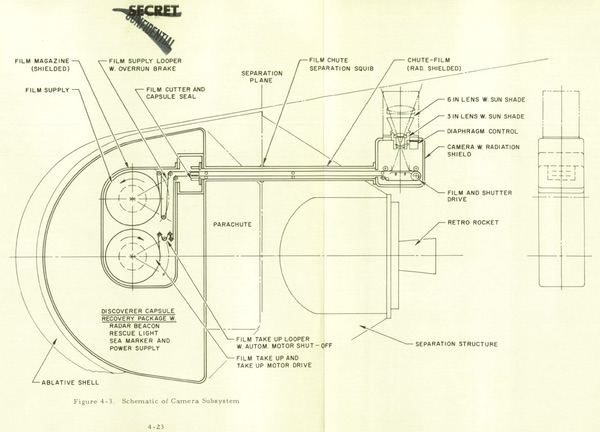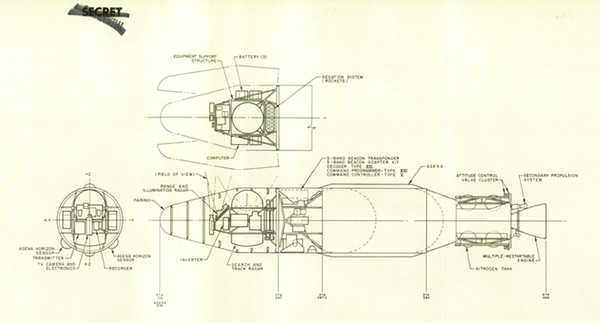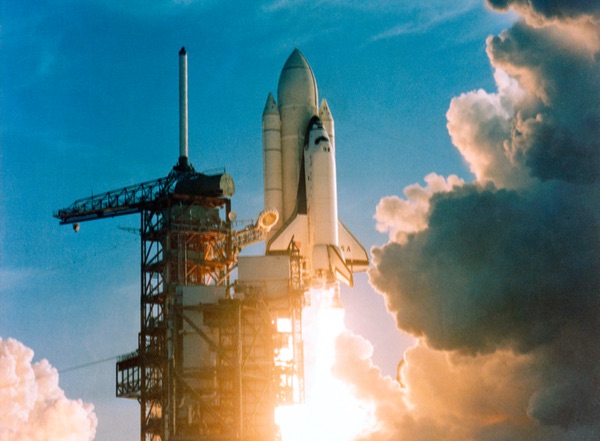Passing in silence, passing in shadowsby Dwayne Day
|
| White’s new book edition has a number of fascinating details. For example, the launch was delayed a short time to improve the imaging opportunity. |
Not long after Columbia’s launch there were rumors that a KH-11 had been used to image the orbiter. But even the existence of the National Reconnaissance Office was classified, and nobody was willing to talk about what its satellites could do. Some journalists speculated, but they apparently had virtually no information, just suspicions. Journalists knew that NASA engineers were concerned about Columbia’s tiles, yet NASA officials declared that they knew the shuttle was safe for reentry.
Rowland White’s book was published in the UK in late 2015 and the United States a few months later. I reviewed it for The Washington Post at the time, and although I could not get into great detail, I was generally impressed with the amount of research that went into the book. (See also “Review: Into the Black”, The Space Review, May 16, 2016.) Any researcher and writer who reads other peoples’ books looks for the things that they personally know to see how well the author reported them. Even though he is not a space expert—White’s previous books were about aviation—White’s account of the shuttle’s development seemed accurate. What really impressed me was that White had some details on the use of the KENNEN to image the shuttle that I did not have.
The hardcover edition of Into the Black had the overall basics of the imaging effort, although not specific details. Even though White did not extensively document his sources, it was not difficult to read between the lines and determine where the information about using the KH-11 to image the shuttle had come from. White’s account in the hardcover version implied that the imaging effort had largely been ad hoc, perhaps even arranged at the last minute. His new version of the story in the paperback edition indicates that the imaging attempt had been planned starting over a year before the flight.
To White’s credit, he conducted additional research after the publication of the hardcover version, talking to at least one new source with first-hand knowledge. The new account is based upon the memories of one of the people who was directly involved in the imaging effort, NASA engineer Ken Young. Young had been working on the shuttle program at the Johnson Space Center when he was told that he needed to obtain a top secret compartmented clearance for a new assignment. After getting the clearance, he started regularly meeting with NRO representatives to work on coordinating the shuttle’s low inclination orbit with a KENNEN satellite in polar orbit.
White’s new book edition has a number of fascinating details. For example, the launch was delayed a short time to improve the imaging opportunity. Also, the KH-11 suffered a problem that threatened its ability to take its picture. The astronauts onboard Columbia also apparently glimpsed the satellite in the distance. White also recounts how impressed Young was with the equipment and facilities he saw when he was first brought onto the project. Clearly a lot of money was being spent on satellite intelligence systems.
 An illustration of the Agena Inspector satellite imaging concept. |
Sat-squared
The concept of imaging one satellite with another dates to the beginnings of the Space Age. One of the missions envisioned for the Dyna-Soar spaceplane in the late 1950s was satellite inspection. Also in the late 1950s, the US Air Force started a development program known as SAINT, for SAtellite INTerceptor. Although intended to destroy other satellites, one variant of SAINT would have been equipped with radar and a television camera for photographing satellites. SAINT was cancelled in 1962.
| By the mid-1960s, at least one CORONA reconnaissance satellite had unintentionally imaged another spacecraft in orbit, prompting NRO officials to begin evaluating if there was any intelligence value to this capability. |
SAINT was followed by another project in the mid-1960s to evaluate using an Agena spacecraft equipped with radar, other sensors, and cameras for inspecting satellites in orbit. That spacecraft included a variant that used film to take better quality photos, returning the film back to Earth. Later in the 1960s, the Program 437 anti-satellite project included a satellite inspection variant that apparently successfully returned a film image of an Agena spacecraft in orbit. But no illustrations of the hardware have ever been declassified, nor has the inspection photograph. What all of these early programs had in common was that they would have flown dedicated inspection missions.
 An illustration of the Agena Inspector satellite imaging concept. |
By the mid-1960s, at least one CORONA reconnaissance satellite had unintentionally imaged another spacecraft in orbit, prompting NRO officials to begin evaluating if there was any intelligence value to this capability. CORONA’s cameras were not powerful enough to determine anything valuable about other spacecraft, but the GAMBIT-1 high-resolution system that entered service in 1963 might have had some potential. There is no information indicating if GAMBIT-1 was used for this purpose before it was retired in 1967. Reconnaissance satellite imagery was classified with the code word “RUFF” at the time, and intelligence captured in the photographs that was unusual and not expected was designated “RUFF Sensitive,” or “RSEN” for short. Satellite-to-satellite photography was known as “sat-squared” or “S2” for short, and became one of the RSEN categories.
In 1995, I was attending an Air Force space history conference at Andrews Air Force Base outside of Washington, DC. Retired Major General David D. Bradburn was one of the speakers. Bradburn had spent many years working at the NRO and on that day in 1995 he was in a rather talkative mood. One of the stories he told was how when Skylab was damaged during launch in May 1973, he realized that an NRO satellite already in orbit could be used to photograph it and assist NASA in evaluating what was wrong with their space station. He convinced his superiors that even though it would cut short part of the mission, assisting NASA was in the national interest. They managed to re-orient the satellite, take the photograph, bring the film back to Earth, and use it to inform NASA on Skylab’s status so that astronauts could fix Skylab’s damage.
When Bradburn told this account, it was clear to me and a colleague that he was probably talking about something that he should not have. This was confirmed when a short time later I mentioned that to a person who was aware of the incident who replied that he did not know that the event had been declassified. It did not take much effort to figure out what reconnaissance satellite had been in orbit at the time of the Skylab launch. It was not a CORONA, because that program had ended in 1972, and KENNEN did not start flying until 1976. The only candidate was a KH-8 GAMBIT-3 satellite. But in 1995, the GAMBIT-3 program had still not been declassified, and Bradburn had not mentioned it by name. Bradburn’s public account and some open source information was sufficient to enable me to write an article referring to the Skylab event.
| The GAMBIT program was finally declassified in 2011, including an official history dating from the 1980s. That history had several deleted sections, including one that almost certainly discussed the Skylab incident. |
Nearly a decade later I was working on a project and met an engineer who told me about working at the “Blue Cube” satellite control center in Sunnyvale, California, in the early 1970s. I mentioned how I had written about some of the programs run out of there and told the engineer about the Skylab case. He said that he had been involved in that effort himself. He explained how in the early 1970s, after the Soviet Union had conducted several co-orbital ASAT tests, the NRO’s West Coast office at Los Angeles Air Force Base had developed the capability to use the GAMBIT-3 to photograph other spacecraft in orbit. He and a few other officers had worked to develop the computer programs to point the GAMBIT’s powerful camera at another satellite and adjust its camera to take a photograph—something that was not easy considering that both spacecraft were moving in different directions at high speed. In fact, according to the engineer, that new capability had only become operational shortly before the Skylab launch, so the damaged spacecraft presented a real-world test of the new capability. Although everybody involved probably took the operation as a challenge, Bradburn had been clear that the NRO had undertaken the mission because it was in the national interest that Skylab succeed.
According to another source I met later, that satellite-to-satellite imaging capability was utilized by the NRO on a number of occasions in the late 1970s and early 1980s with increasing success. The source indicated that Sunnyvale’s Blue Cube had a highly-classified collection of photograph enlargements of Soviet spacecraft, notably its Almaz manned military space stations. The GAMBIT program was finally declassified in 2011, including an official history dating from the 1980s. That history had several deleted sections, including one that almost certainly discussed the Skylab incident.
When the KH-11 KENNEN entered service in late 1976, its operators almost certainly began evaluating its ability to image other satellites in orbit. The GAMBIT-3 used to photograph Skylab carried film, and bringing that film with its vital photograph of Skylab back to Earth quickly meant cutting short the rest of the mission, limiting the overall intelligence take. The KENNEN had no such limitations. According to a 1971 document declassified at the request of researcher Jeff Richelson, the original code name for the program while in development was ZAMAN. It was changed to KENNEN because that word in Middle English meant “to perceive.”
Six months after the April 1981 Columbia mission, Aviation Week published an article stating that the shuttle had been imaged by a reconnaissance satellite during its flight. In 1983, British researcher Anthony Kenden used publicly available satellite tracking data to determine when the imaging might have occurred.
When the Columbia was destroyed in 2003 during STS-107, there was substantial public discussion about whether the orbiter could have been inspected with a reconnaissance satellite after NASA engineers suspected it might have been impacted by foam debris. That discussion prompted Canadian satellite observer Ted Molczan to revisit the available orbital data on the STS-1 mission and the KH-11 KENNEN reconnaissance satellites in orbit at the time. Molczan identified several possible orbital passes. It appears that Rowland White used Molczan’s analysis for Into the Black. But the new account in the revised edition of the book adds considerably to our understanding of what happened during that mission, 36 years ago, when a deep black satellite photographed a shiny white space shuttle orbiter against the darkness of space.
